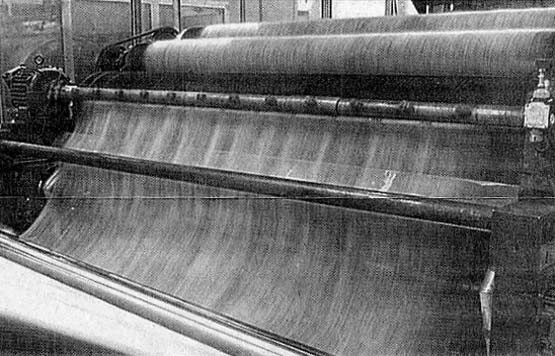Foss Manufacturing in Hampton Feels the Love of Synthetic Fiber
By Michael McCord
Herald Sunday, Sunday, July 24, 2005
[The following article is courtesy of Herald Sunday and Seacoast Online.]

What do I know from synthetic fibers? Not a whole lot except I do have a long-standing bias against polyester and the wide-collared polyester shirts and permanent press pants from the 1970s.
It was time to address my synthetic fibers education deficit because in the past century synthetic fibers have invaded nearly every industry and become an integral but mostly unheralded ingredient of every product imaginable in our modern lives. That is why I called Jeff Dellinger, managing director of the fiber business unit at Hampton-based Foss Manufacturing.
Foss was founded in 1954 in Haverhill, Mass., by G. Woody Foss. The company began making heel and shoe stiffeners for shoes and evolved to fiber production in 1980.
In the era of globalization, Foss has found a niche for itself in the non-woven specialty fiber sector, CEO Stephen Foss told me, and one of its main strengths is a relentless focus on research and development that allows innovative and creative uses for its products.
"We are unique," Dellinger said.
Foss makes fibers for other companies to incorporate into their products. Foss also makes fibers for itself to create end-use products that it sells, Dellinger explained.
The privately held company has been traditionally mum on matters such as income, how many employees it has, and the identity of the countless clients it serves. The company does say it has facilities in North America, Europe and Australia, and it serves every major commercial and consumer sector of the economy from automotive to home decorating to athletic and medical apparel. It also says its processes are environmentally friendly.
Synthetic fibers have come a long way since 1889 when, according to the Fiber Economics Bureau, a French chemist "stunned Paris" when he created the first strands of an artificial fiber we now know as rayon. Manufactured fibers -- in short those that aren't, for example, cotton, wood and silk -- accounted for 1 percent of products at the turn of the 20th century. More than a century later, the output is up to 70 percent and growing for products such as automotive interiors to cheap T-shirts to bed liners.
One thing I learned quickly from Dellinger is that not all polyesters are created equally. Polyester is Foss' staple product, and Dellinger said there is a major difference between commodity and specialty fibers.
"If it's cheap and easy, it will be done in Asia," he said.
The commodity bulk polyester churned out by the tens of millions of tons from factories in Asia has little in common with the more precise deployment of tons of polyester created by Foss. In other words, think value-added high-end and you get a sense of how Foss and other American manufacturers survive in a hyper-competitive global marketplace.
The industry is going in so many directions," Dellinger told me from his Foss office in Charlotte, N.C.Dellinger had his own change of direction when he took his political science degree and jumped into the furniture industry, the state's dominant manufacturing activity. Dellinger hails from Hickory, N.C., which he proudly told me "is the furniture capital of the United 3 States."
At first glance, there's not much of a connection between furniture and polyester until you consider the major component in every recliner and bed comes loaded with synthetic fibers.
Since 1986, Dellinger acquired an on-the-job synthetic fibers Ph.D. that led to his joining Foss in December 2004.
To an ill-educated outsider like myself, Dellinger is a patient tutor about the wide world of polyester development. And I do mean wide. Think soft drink bottles and your carpet at home and you get the chemical picture.
What's happening today would likely make that 19th century French chemist weep with mad-scientist joy -- especially, I imagine, if he were working for Foss, which has countless patented and trademarked products and design processes. (We should also take a moment to thank the person who came up with the name polyester -- polythyleneterephthalate, after all, is a mouthful, even for chemists).
In certain places, Dellinger concedes "polyester is not the optimum choice." But those places are shrinking daily because polyester, which was first produced commercially by Dupont in 1953, has become a functional, even cool, synthetic fiber du jour.
While I'm still stuck in the 1970s version of polyester hell -- stiff, suffocating shirts that annoyed my skin to no end -- Dellinger talks about polyester uses for athletic wear that not only breathes but dissipates sweat. Or polyester that retards ultraviolet rays degradation, which has been good news for patio furniture and awnings.
And there's Fossshield technology, which must be considered one of the real breakthroughs in the continual battle between the human race and bacteria. Combine quality polyester with silver ions, which I learned is one of the oldest and natural antimicrobial agents, and you get a fiber that, the company claims, keeps 650 types of bacteria from spoiling your life.
Of course, this technology is great for medical apparel users. But this antimicrobial fiber combination has uses in every sector from the cabin linings in boats to filtration systems to your blinds and curtains at home.
What next on the innovative horizon, Dellinger explained, is creating more fire-retardant fibers that would, again, serve every imaginable sector.
My brief immersion in the polyester universe led me to imagine my own synthetic fiber revision. If the 1960s classic film "The Graduate" is remade, one of its most memorable lines should be revised for modern sensibilities. "Polyester" and not "plastics" should be the career path suggestion.
Michael McCord is the business editor of the Portsmouth Herald. His fashion sense can be best described as wrinkled, 100 per cotton.
